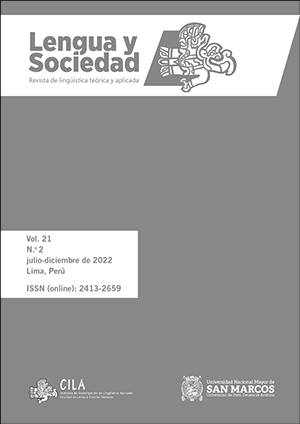Empirical difficulties in the approach to the so-called aspectual se: diachronic evidence in rioplatense Spanish
DOI:
https://doi.org/10.15381/lengsoc.v21i2.22766Keywords:
aspectual se, history of Spanish, CORDIAM, diachronic linguistics, empirical dataAbstract
In this paper we deal with constructions that contain the so-called aspectual se in Spanish in order to determine whether the properties associated with these constructions are reflected in historical data of American Spanish. Taking as a starting point the observations of De Benito (2021) on data from peninsular Spanish from the COSER corpus, we show that the theoretical-practical difficulties in the study of this phenomenon are not exclusive to current Spanish nor to peninsular Spanish, but are evident in data from American Spanish from a diachronic perspective. By collecting data from the CORDIAM corpus, we illustrate instances of aspectual se in the Spanish of the Río de La Plata (Argentina and Uruguay) from the 16th-19th centuries. We conclude that the most widespread analyses are based on a series of strict contrasts and (a)grammaticality tests that are not necessarily reflected in the observed diachronic data. This is one of the central reasons why studies of aspectual se have not been able to arrive at a definitive approach to the data, with tools that cannot be extended to all cases.
References
Aaron, J. y Torres, R. (2005). Quantitative measures of subjectification: A variationist study of Spanish salir(se). Cognitive Linguistics, 16(4), 607-633. https://doi.org/10.1515/cogl.2005.16.4.607
Academia Mexicana de la Lengua (s. f.). Corpus Diacrónico y Diatópico del Español de América. https://www.cordiam.org
Alcina, J. y Blecua, J. (1975). Gramática española. Ariel.
Armstrong, G. (2013). Agentive reflexive clitics and transitive se constructions in Spanish. Borealis, 2(2), 81-128. https://doi.org/10.7557/1.2.2.2526
Basílico, D. (2010). The se clitic and its relationship to paths. Probus, 22(2), 271-302. https://doi.org/10.1515/prbs.2010.010
De Benito, C. (2021). Is there really an aspectual se in Spanish? Folia Linguistica, 55(1), 195-230. https://doi.org/10.1515/flin-2020-2074
Bogard, S. (2006). El clítico se. Valores y evolución. En C. Company (Dir.), Sintaxis histórica de la lengua española. Primera parte: La frase verbal (pp. 753-870). Fondo de Cultura Económica-Universidad Nacional Autónoma de México.
Campanini, C. y Schäfer, F. (2011). Optional SI/SE constructions in Romance: A low- applicative analysis [sesión de conferencia]. Going Romance 24, Leiden University, Países Bajos.
De Miguel, E. y Fernández, M. (2000). El operador aspectual se. Revista Española de Lingüística, 30(1), 13-44. http://revista.sel.edu.es/index.php/revista/article/view/1640
De Smet, H. (2012). The course of actualization. Language, 88(3), 601–633. http://www.jstor.org/stable/23251865
Di Tullio, A. (2012). La construcción de la lectura agentiva del se no argumental. En V. Bellosta von Colbe y M. García (Eds.), La construcción de la Aspectualidad-Transitividad-Referencialidad. Las lenguas románicas en contraste (pp. 69-85). Peter Lang.
Di Tullio, A. (2014). Manual de Gramática del Español. Waldhuter.
Dowty, D. (1979). Word meaning and Montague grammar. Kluwer Academic Publishers.
Dowty, D. (1991). Thematic Proto-roles and Argument Selection. Language, 67(3), 547-619. https://doi.org/10.2307/415037
Fernández, I. (2005). Corpus Oral y Sonoro del Español Rural. http://www.corpusrural.es/
Fernández, S. (1986). Gramática española. 4. El verbo y la oración. Arco/Libros.
Fischer, O. (2008). On analogy as the motivation for grammaticalization. Studies in Language, 32(2), 336–382. https://doi.org/10.1075/sl.32.2.04fis
Gómez, L. (1992). Valores gramaticales de se. Arco/Libros.
Krifka, M. (1989). Nominal reference, temporal constitution in event semantics. En R. Bartsch, J. van Benthem y P. van Emde Boas (Eds.), Semantics and Contextual Expression (pp. 75-115). Foris Publications.
Krifka, M. (1992). Thematic relations as links between nominal reference and temporal constitution. En I. Sag y A. Szabolsci (Eds.), Lexical Matters (pp. 29-53). Stanford: CSLI Publications.
Krifka, M. (1998). The origins of telicity. En S. Rothstein (Ed.), Events and Grammar (pp. 197-235). Kluwer Academic Press.
Levin, B. (1999). Objecthood: An Event Structure Perspective. Proceedings of CLS 35, volume 1: The Main Session, Chicago Linguistic Society, University of Chicago, Chicago, IL, 223-247.
MacDonald, J. (2017). Spanish aspectual se as an indirect object reflexive: The import of atelicity, bare nouns, and leísta PCC repairs. Probus, 29(1), 73-117. https://doi.org/10.1515/probus-2015-0009
Mackenzie, I. (2019). Language structure, variation and change: the case of Old Spanish syntax. Palgrave Macmillan / Springer Nature.
Martín, M. A. (1979). Las construcciones pronominales: paradigma y desviaciones. Gredos.
Moreno, J. C. (2021). Origen y evolución de la sintaxis compleja. Lengua y Sociedad, 20(2), 13–35. https://doi.org/10.15381/lengsoc.v20i2.22186
Nishida, C. (1994). The Spanish reflexive clitic se as an aspectual class marker. Linguistics, 32(3), 425–458. https://doi.org/10.1515/ling.1994.32.3.425
Pustejovsky, J. (1991). The Syntax of Event Structure. En B. Levin y S. Pinker (Eds.), Lexical and Conceptual Structure (pp. 47-81). Blackwell.
Romero, C. y Teomiro, I. (2012). La relación entre estructura eventiva y papeles temáticos: el se aspectual del español. Revista de Filología Románica, 29(2), 233-243. https://doi.org/10.5209/rev_RFRM.2012.v29.n2.40156
Sánchez, C. (2002). Las construcciones con se. Visor Libros.
Sanz, M. y Laka, I. (2002). Oraciones transitivas con se: el modo de acción en la sintaxis. En C. Sanchez (Ed.), Las construcciones con se (309-338). Visor Libros.
Vendler, Z. (1957). Verbs and Times. The Philosophical Review, 66(2), 143-160. https://doi.org/10.2307/2182371
Zagona, K. (1996). Compositionality of aspect: Evidence from Spanish aspectual se. En C. Parodi (Ed.), Aspects of Romance linguistics. Selected papers from the LSRL XXIV (pp. 475-488). Georgetown University Press.
Downloads
Published
Issue
Section
License
Copyright (c) 2022 José María Oliver

This work is licensed under a Creative Commons Attribution 4.0 International License.
AUTHORS RETAIN THEIR RIGHTS
a. Authors retain their trade mark rights and patent, and also on any process or procedure described in the article.
b. Authors can submit to the journal Lengua y Sociedad, papers disseminated as pre-print in repositories. This should be made known in the cover letter.
c. Authors retain their right to share, copy, distribute, perform and publicly communicate their article (eg, to place their article in an institutional repository or publish it in a book), with an acknowledgment of its initial publication in the journal Lengua y Sociedad.
d. Authors retain theirs right to make a subsequent publication of their work, to use the article or any part thereof (eg a compilation of his papers, lecture notes, thesis, or a book), always indicating its initial publication in the journal Lengua y Sociedad (the originator of the work, journal, volume, number and date).



























